Free Asian Recipes from Singapore for Cooking Singaporean Food
Some of the recipes cross over from the Malaysian Asian Recipe page, Singapore has a unique blend of spices that is truly remarkable.
| Chicken Recipes | Beef Recipes | Seafood Recipes | Vegetarian Recipes | Dessert Recipes |
Singapore Food can fall into three categories; Nonya Food, Chinese Food, Malay Food and Indian Food. Though some of these recipes have their origins from Malaysia as well as from these four categories, there is a unique different taste that is Singapore altogether.
 Nonya Cuisine
Nonya Cuisine
The influence of Nonya or Nyonya cuisine can be seen in most Singaporean dishes.
These dishes tend to be spciy hot using a variety of ginger and turmeric, not to mention curry and kaffir leaves
as well as the very pungent but tasty shrimp paste, shallots, tarmarind and chillies. In the 1800s, Malaysian
women married Chinese settlers due to the shortage of avaiable women at the time. In time these Malaysian women
became known as Nonyas and their descendants known as the Straits Chinese. These Nonyas were quite creative
with their dishes, in fact, they use a lot of their husband's influences of dishes from China and came up with
their own unique and creative dishes, combining Chinese and Malay/Indonesian cooking.
Though using and preparing Nonya dishes can be quite tedious and long, the end results are quite superior and wonderful. I have grown up with a mother and grandmother who are very knowledgable in Nonya cuisine and have always marvel at their creation. An interesting Singaporean Nonya dish to try is Bak Ku Teh or Pork Rib Tea Soup where you will find a variety of Chinese herb and spices infused into this delicate soup.
Chinese Cuisine
The Chinese cooking in Singapore is a blend of Cantonese and Szechuan. Cantonese cuisines is very light
and has a lot of subtle yet complex flavors. Examples of the typical Cantonese dishes include
share fin soup, spring rolls, roast suckling pig and
wonton noodles.
There are also various dim sum dishes that are influenced by the Cantonese and Szechuan cooking as well.
Another type of Chinese cuisine is the using Hokkien noodles which is a type of fat noodles that is
stir-fried and is very delicious. (
Singaporean Hokkien Noodles)
Malay Cuisine
Because of its closeness to Malaysia (geographically and relationship), Singapore owes a lot of its dishes
to the Malaysian influence, not to mention Sumatra and Java as well. Pork is not common in Malay inspired
dishes as Muslims do not consume pig because they believe the animal to be unclean. The use of
agar agar in desserts is wide spread, for example,
Coconut Jelly is
excellent dessert to make if you want a no-fuss dessert. Another delicious dish that borrows heavily
from the Malayan cuisine is the ever popular
Singaporean Laksa. Other
dishes include Mee Siam,
lontong, Mee Goreng, Mee Soto,
Mee Rebus
and so much more.
Indian Cuisine
As if there wasn't enough influences from three different cultures, Singapore cuisine is also influnced
from northern and southern India. The cuisine of Singaporean Indian has a wide range of variety
with different regions and parts contributing its own unique flavor. The use of chillies, be their fresh
or ground to make curry powders is essential. Examples of Indian inspired cuisine include
Roti Canai,
Mutton Korma, Soup Kambing (Indian
Mutton Soup) and many more. Desserts include Thosai, a type or rice and lentil pancake
and Murukku which is a type of
Indian biscuits.
The following recipes were gleamed from various resources. I try to include recipes that are as authentic as possible, with information from my mother. This is often difficult as she does not have a recipe book and most of the measuring system she has is typical Nonya mentality which is to 'agak-agak' or to 'guess till it feels right'. At any rate, these are the closest that I can find and I hope you enjoy these hawker style Singaporean recipes.
Singapore Recipes
-
Index of New Singaporean Recipes:
- Mango Pickle NEW
- Coconut Milk Rice NEW
- Soy Sauce Duck NEW
- Steamed Silky Eggs NEW
-
Spicy Long Beans NEW
Chicken, Duck, Quail & Poultry Recipes:
- Chicken in clay pot
- Chicken Macaroni in Tomato Broth
- Hainan or Hainanese Chicken Rice popular
- Singapore Satay popular
-
Spicy Coconut Chicken
Pork, Mutton, Beef, Veal and Lamb Recipes
- Bak Ku Teh (Pork Rib Tea Soup) popular
- Grilled Pork Ribs
- Hokkien Noodles
- Singaporean Curry Puffs popular
-
Spare Ribs in Black Bean Sauce popular
Seafood Recipes
- Chillie Crabs or Lobster popular
- Crabmeat Omelette
- Fish Head Curry popular
- Fish Head Noodle Soup
- Otak Otak (Spicy Fish Cakes) popular
- Oysters in Egg Omlette
- Prawns in Satay Sauce
- Singaporean Fried Whole Fish
- Stir Fry Salted Fish with Bean Sprouts
- Steamed Fish with Ginger and Chilli popular
-
Steamed Fish in Ginger Sauce
Vegetarian Recipes
- Egg Bean Curd
- Crispy Deep Fried Beancurd with Chillies and Salt
- Rojak (Singaporean Salad) popular
- Steamed beancurd
- Stewed sea cucumber
- Stir-Fried Vegetable Assortment popular
-
Vegetables with Mushrooms and Oyster Sauce
Noodles, Rice & Bread Recipes
- Century Egg and Minced Pork Congee popular
- Chicken Satay Noodles
- Fresh Rice Noodle Snack (Chee Cheong Fun) popular
- Gai See Mee (Chicken, mushroom & noodles)
- Singapore Laksa popular
-
Wonton Noodles (Kon Loh Mein) popular
Dessert & Sweets Recipes
- Coconut Jelly
- Lotus Seed Soup (Lin Chi Kang)
- Kaya, Traditional Coconut Egg Jam popular
- Red Bean Soup popular
- Sago Pudding
- Singaporean Agar-Agar Jello
- Singapore Sling (Alcholic Beverage) popular
- Tropical Fruit Salad
Chicken Recipes
Beef & Pork Recipes
Seafood Recipes
Vegetarian Recipes
Dessert Recipes
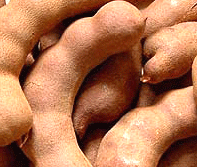 Adds a unique sour flavour to various seafood dishes. Also sweeten and eaten as a candy. To use, discard
shell and extract the pulp, add some hot/warm water, soak for several minutes and knead till the pulp dissolves,
then strain. Yod Makhaam(thai), the young leaves of the tamarind tree, gives a bitterish taste to a special
curry. Subsitute: lemon or lime.
Adds a unique sour flavour to various seafood dishes. Also sweeten and eaten as a candy. To use, discard
shell and extract the pulp, add some hot/warm water, soak for several minutes and knead till the pulp dissolves,
then strain. Yod Makhaam(thai), the young leaves of the tamarind tree, gives a bitterish taste to a special
curry. Subsitute: lemon or lime. Banana leaves are used much like Alluminum foil but it imparts a special flavour to the
food cooked in it. Food wrapped and grilled in Banana leaves is called pepesan in Indonesia.
Soak leaves in hot water or over flame to soften and wipe clean with kitchen towels. Sunning it could
also help to release its flavour.
Banana leaves are used much like Alluminum foil but it imparts a special flavour to the
food cooked in it. Food wrapped and grilled in Banana leaves is called pepesan in Indonesia.
Soak leaves in hot water or over flame to soften and wipe clean with kitchen towels. Sunning it could
also help to release its flavour.  These expensive dried mushrooms should be stored in a cool, dark, dry place to prevent from going mouldy.
Soak in hot water for 20 mins before use, trim off hard stems and use caps whole or shredded.
These expensive dried mushrooms should be stored in a cool, dark, dry place to prevent from going mouldy.
Soak in hot water for 20 mins before use, trim off hard stems and use caps whole or shredded.  The popular Black Chinese Vinegar is
sold in most Chinese food stores. It is a dark, mild tasting vinegar. Subsitute with malt vinegar, rice vinegar
or cider diluted with water.
The popular Black Chinese Vinegar is
sold in most Chinese food stores. It is a dark, mild tasting vinegar. Subsitute with malt vinegar, rice vinegar
or cider diluted with water.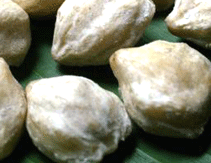 A common ingredient in making fresh spice paste, it adds a subtle taste to many dishes. When use
for thickening, maybe replaced with other nuts such as macademia or cashew. Usually sold shelled.
Subsitute: Brazillian/ Macadamia or Cashew Nuts.
A common ingredient in making fresh spice paste, it adds a subtle taste to many dishes. When use
for thickening, maybe replaced with other nuts such as macademia or cashew. Usually sold shelled.
Subsitute: Brazillian/ Macadamia or Cashew Nuts.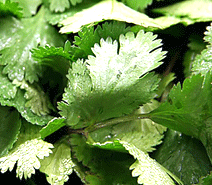 Almost never cooked, it has a refreshing and distinct flavour(hint of parsley). Usually leaves and
stems are used as garnish coupled with spring onions or in salads. Less common in Malay/Indonisian kitchens.
Grown easily from seeds. Keep roots in water and cover leaves in a plastic bag will keep it good in the fridge
for at least a week.
Almost never cooked, it has a refreshing and distinct flavour(hint of parsley). Usually leaves and
stems are used as garnish coupled with spring onions or in salads. Less common in Malay/Indonisian kitchens.
Grown easily from seeds. Keep roots in water and cover leaves in a plastic bag will keep it good in the fridge
for at least a week. 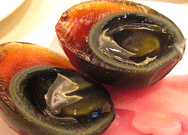 A preserved duck egg covered in rice husks and mud, the york and white turn to a greenish black
and has a peculiar taste. Eaten as it is with preserved young ginger slices, or in various dishes.
Those with a soft york is much sought after.
A preserved duck egg covered in rice husks and mud, the york and white turn to a greenish black
and has a peculiar taste. Eaten as it is with preserved young ginger slices, or in various dishes.
Those with a soft york is much sought after. 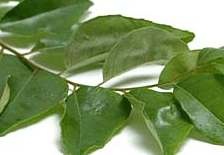 From Indian curry tree, fresh leaves has a strong distinct fragrant that's not present in the dried leaves.
Use only fresh leaves if possible, however, if you are unable to find fresh, then dried leaves can be used.
From Indian curry tree, fresh leaves has a strong distinct fragrant that's not present in the dried leaves.
Use only fresh leaves if possible, however, if you are unable to find fresh, then dried leaves can be used. Very subtle flavour used basically for its texture in Chinese influenced dishes. Soak in warm water for
5 minutes, remove all hard bits and rub to clean off dirt. Woodear fungus is the larger and thicker variety,
often shredded before use.
Very subtle flavour used basically for its texture in Chinese influenced dishes. Soak in warm water for
5 minutes, remove all hard bits and rub to clean off dirt. Woodear fungus is the larger and thicker variety,
often shredded before use. 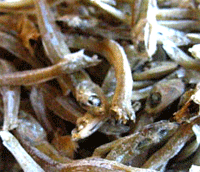 The young of a several species of fish. It is somewhat salty and often used in omelette or deep
fried as a side dish.
The young of a several species of fish. It is somewhat salty and often used in omelette or deep
fried as a side dish.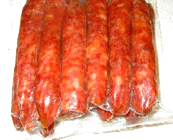 Contained in processed intestine, they usually contain pork or liver, rice wine, sugar and various spices.
Pork sausages are brighter red in color while those of liver are dark maroon. Contains a fair amount of
fat depending on the manufacturer . Often steamed on a plate over cooked rice producing a wonderful
fragrant and oil which is used to flavour rice. Those with not too much fat (the visible white patches) are
usually preferred. They can be stored for a long time. Slice at an angle. Avoid overcooking or the fat
will be lost along with its wonderful flavour.
Contained in processed intestine, they usually contain pork or liver, rice wine, sugar and various spices.
Pork sausages are brighter red in color while those of liver are dark maroon. Contains a fair amount of
fat depending on the manufacturer . Often steamed on a plate over cooked rice producing a wonderful
fragrant and oil which is used to flavour rice. Those with not too much fat (the visible white patches) are
usually preferred. They can be stored for a long time. Slice at an angle. Avoid overcooking or the fat
will be lost along with its wonderful flavour. 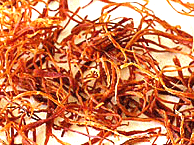 It is the hand picked and dried stigmas of a flower. In Southeast Asia, it's only used by the
Indians for its intense fragrance though it is also used by the Chinese as a medicine. It also
gives food a yellowish color but being the most expensive spice in the world it is rarely used
just for that purpose. (For colouring purpose, usually turmeric is used.) Usually, a tiny quantity
is soaked in water and the resulting orangy yellow liquid is added to food.
It is the hand picked and dried stigmas of a flower. In Southeast Asia, it's only used by the
Indians for its intense fragrance though it is also used by the Chinese as a medicine. It also
gives food a yellowish color but being the most expensive spice in the world it is rarely used
just for that purpose. (For colouring purpose, usually turmeric is used.) Usually, a tiny quantity
is soaked in water and the resulting orangy yellow liquid is added to food.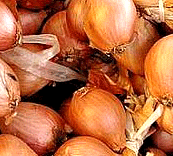 Those used in Southeast Asia are maroonish in color and small ideal for deep frying. Replacable by small
onions, those with a stronger flavour are preferable.
Those used in Southeast Asia are maroonish in color and small ideal for deep frying. Replacable by small
onions, those with a stronger flavour are preferable.  Sold in cans, sometimes fresh, they are small, depe grey ball-shaped mushrooms which in cross-section
reveal the shape of a smaller mushroom inside. Once opened, they don't keep for more than a few days
in the refrigerator.
Sold in cans, sometimes fresh, they are small, depe grey ball-shaped mushrooms which in cross-section
reveal the shape of a smaller mushroom inside. Once opened, they don't keep for more than a few days
in the refrigerator.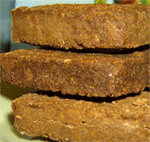 One of the special ingredients that give Southeast Asian cuisine its very special flavour.
It is strong smelling, a little wet and saltish. Watch the amount of salt used in recipes that
also requires blacan. Toast over fire on both sides to release its special aroma before use.
Powdered ready to use type is also available. Keep well without refrigeration for months. The
lighter pinkish type is not used for making sambal blacan.
One of the special ingredients that give Southeast Asian cuisine its very special flavour.
It is strong smelling, a little wet and saltish. Watch the amount of salt used in recipes that
also requires blacan. Toast over fire on both sides to release its special aroma before use.
Powdered ready to use type is also available. Keep well without refrigeration for months. The
lighter pinkish type is not used for making sambal blacan. 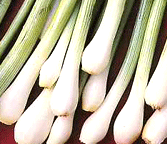 One of the most popular garnishes often couple with coriander. Combination with ginger
is also popular in Chinese stir fry dishes. These do not keep well for weeks in the refrigerator so it's best
to use within two to three days of purchasing.
One of the most popular garnishes often couple with coriander. Combination with ginger
is also popular in Chinese stir fry dishes. These do not keep well for weeks in the refrigerator so it's best
to use within two to three days of purchasing. Thin parchment-like wrapper sold in packs of 12 to 20 pieces. Used to wrap fried foods, they
turn very crisp when fried. Keep damp during use by covering with a slightly moistened cloth.
Store unsued wrappers, well wrapped in plastic in the freezer.
Thin parchment-like wrapper sold in packs of 12 to 20 pieces. Used to wrap fried foods, they
turn very crisp when fried. Keep damp during use by covering with a slightly moistened cloth.
Store unsued wrappers, well wrapped in plastic in the freezer. Often called "the potatoes of the tropics". When choosing yam, pick the lighter ones, but not the dried
out ones. Frozen yam is also available. Sometime the sap may cause allegic reactions to skin, handle
raw peeled yam with gloves.
Often called "the potatoes of the tropics". When choosing yam, pick the lighter ones, but not the dried
out ones. Frozen yam is also available. Sometime the sap may cause allegic reactions to skin, handle
raw peeled yam with gloves. 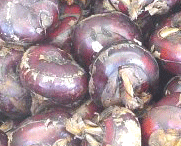 Freshly peeled water chestnuts is crunchy and juicy and are often eaten as a fruit. Fresh waterchestnuts
is glossy and full and hard to the touch. any yellowish part should be discarded. Often covered in mud
and need to be thoroughly brushed. Also available in cans.
Freshly peeled water chestnuts is crunchy and juicy and are often eaten as a fruit. Fresh waterchestnuts
is glossy and full and hard to the touch. any yellowish part should be discarded. Often covered in mud
and need to be thoroughly brushed. Also available in cans.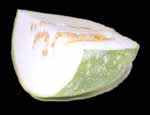 This giantic melon looks like a water melon but has a bland tasting creamy-green flesh. Good for soups.
This giantic melon looks like a water melon but has a bland tasting creamy-green flesh. Good for soups.